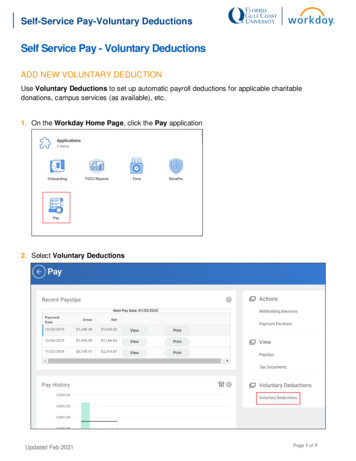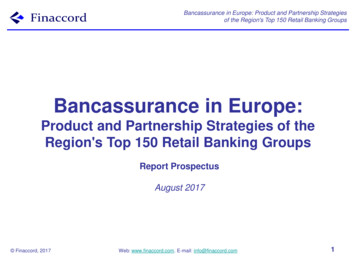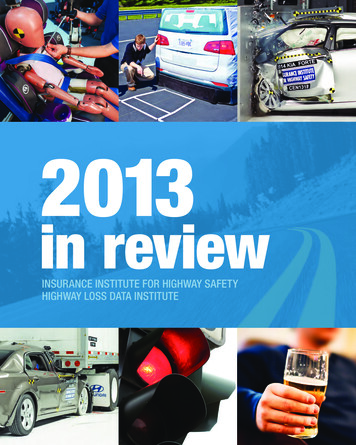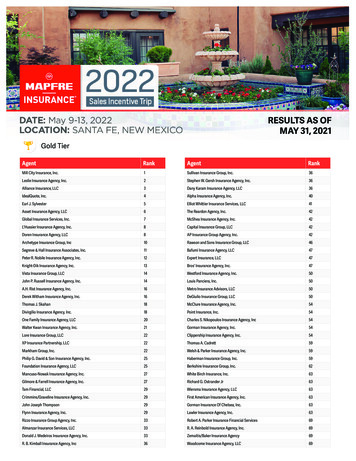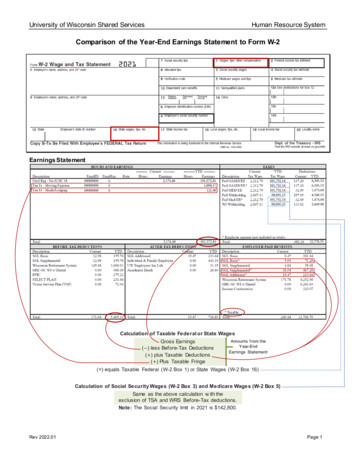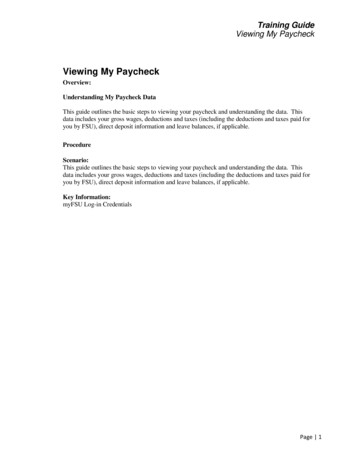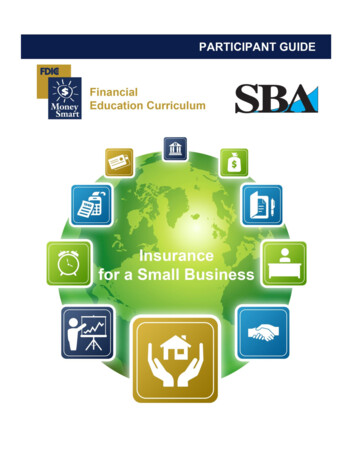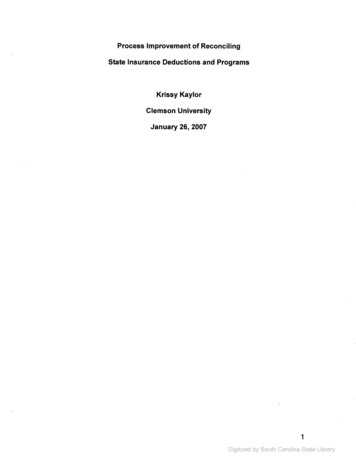
Transcription
Process Improvement of ReconcilingState Insurance Deductions and ProgramsKrissy KaylorClemson UniversityJanuary 26, 20071Digitized by South Carolina State Library
Problem statement:The process used to reconcile state insurance deductions and transactions atClemson University with the Employee Insurance Program results in delay ofrefunds and collections and less staff time for completion of other job duties.In the past, some employees have waited three or more months to be refundedor charged for collections from insurance transactions. Employees are entitled totimely refunds and timely collections are needed to fund the payment of the stateinsurance bill each month. Previously, refunds and collections for adjustments orchanges were made after reconciliation for the month was completed.Reconciling continues to stay behind due to increased retirements and hiring,which results in a greater need for counseling.Improving the state insurance reconciliation process is in line with the ClemsonUniversity's commitment to "Lean Thinking" (Womack, and Jones, LeanThinking). Management received training on the purpose of lean, the process,commitment of top management and our role.The lean approach or "Kaizen" is defined as "small daily improvementsperformed by everyone. Kai means "take apart" and zen means "make good."The point of kaizen implementation is the total elimination of waste." (Tapping,and Shuker, Value Stream Management for the Lean Office, p.148). "Kaizen" isbeing implemented at Clemson University to determine areas that provi?e value2Digitized by South Carolina State Library
where "muda" defined as "any activity that consumes resources but creates novalue" can be eliminated and money found, while not eliminating staff, butreallocating resources where needed. (Womack, and Jones, Lean Thinking p.350).The process of lean involves assembling a team to look at a particular process,in detail from beginning to end, with the direct people who complete the processand determining the recommendations.Initially, the University committed tolooking at about five processes. This was suggested by a consultant who washired to conduct lean training and facilitate the initial phase of lean. Managementsolicited ideas from different departments and determined which processimprovements would provide the most "bang for our buck." Then teams werecreated to conduct the reviews. The idea is to devote the total resources neededfor a week, to quickly determine and implement the best recommendation.The University's goal is to become a top 20 public university.With statesupported funds continuing to decrease, it is imperative the University find othersources of funding to help reach that goal. In addition to the quest to increasemoney from research grants, the University is utilizing lean as a way to findmoney internally. Top management has been involved from the initial stage oflean, during the training and is continuing to playa role with process review.3Digitized by South Carolina State Library
Our role as managers is to be supportive with our time and staff who may beasked at some point to help on a team.We were also asked to determineprocesses or functions within the units we supervise and conduct minilean/Kaizen sessions.The reconciling process is a mini-lean session for theinsurance unit.The first response to a solution for faster refunds, collections and time forcompletion of other job duties may be to add more staff. However, that is not anoption. A few years ago the benefits unit was cut a counselor position. It hastaken years to document and gather support to obtain the position back.Data collection:The data collected includes reasons for the project, flow charts, project schedule,extraction of data from the Employee Insurance Program to compare to ClemsonUniversity's data for insurance, estimated current processing time for refunds andcompletion of reconciliation responsibilities and estimated costs.It was important to document justification for the project to obtain the supportfrom management, staff and the technical team to prioritize this project in relationto other goals for the unit, department and organization.To ensure a new process did not eliminate any necessary steps, the benefitscounselor responsible for reconciling,Mary Lee,wasincludedin the4Digitized by South Carolina State Library
development of flow charts of Clemson University's processes [appendices 1(DOC 1a-1j) and 2 (DOC 2a-2c)]. Since the University of South Carolina has similarreconciling needs, Clemson University decided to meet with their staff and flowchart their process for reconciling to compare [appendix 3 (DOC3a-3f)].During the unit staff retreat, the insurance team met to discuss reasons for theproject, resources needed to complete the project and a projected timeframe forcompletion, understanding that success also depended on the schedule ofClemson University's technical team.Clemson University contacted the Employee Insurance Program to find out thecurrent information that could be extracted from their system online, the formatand timeframe available.Using this information and the flow charts of currentprocesses from Clemson University [appendices 1 (DOC 1a-1j) and 2 (DOC 2a-2c)]and University of South Carolina [appendix 3 (DOC3a-3f)], benefits staff andtechnical staff developed a flow chart of a new improved process to reconcilestate insurance [appendix 4 (DOC 4a-4e)].The new process will speed uprefunds and collections, while providing more time to complete other job duties.Based on review of 2006-2007 refund request forms submitted, there wereseveral instances where employees had to wait up to 3-4 months or longer toreceive an insurance refund. It is estimated that over % of the refunds issuedduring this time period were 2-3 months after the insurancech ngeor5Digitized by South Carolina State Library
termination was made. By viewing the 2007-2008 refund request forms we willbe able to quickly identify refunds that are processed more than 2 months old.Our goal is 1-2 months wait time to receive a refund for 95% or more of thepeople due a refund. We'd also take into consideration some refunds may beolder due to special circumstances, such as the state approving retro-activechanges and terminations of programs. When we stopped the old method ofreconciling a decision was made in the unit to write up the refunds as follow up tocounseling, instead of writing them up as a part of the reconciliation process.This simple change has already made an impact of more timely refunds.The process of reconciling all state insurance programs with the former and newmethod starts as soon as the second pay check of the month is confirmed bypayroll (for insurance premiums to be deducted).The time frame for the formerprocess required an average of one week staff time at a cost of 762.75 permonth ( 20.34 hourly rate *37.5 work hours per week) *12 months a year 9,153 yearly cost. This meant having to work on reconciling betweencounseling duties (many interruptions). Since the process required balancingpremium amounts to the penny for each program, much research would berequired when Clemson did not balance with the State - usually due to data entryerrors in Access databases (decks) or on Excel spreadsheets. This could be verytime-consuming on most occasions. Also, the method of reconciling eachprogram individually was time consuming. Our goal was at a minimum to cut the6Digitized by South Carolina State Library
work time in half.Savings in this area will be applied to other counseling jobduties.In addition to the staff time for reconciliation, the unit would spend approximately1 minute per transaction to key information into the insurance transaction accessdatabase.Each year the unit keys 8,000 state insurance transactions in thisdatabase, a cost of 2,575.94 per year. This amount was calculated as follows: 1minute *8,000 transactions 8,000 minutes 160 minutes in an hour 133.33 hoursa year *19.32 (average hourly rate for unit staff). The goal with the new methodwas to eliminate this data entry point.The number of errors using the old system was not tracked, just adds, changesand terminates. The initial onset of the new method was more time-consumingbecause of determining and clearing up errors that had not been caught in theold method (a 3 % page spreadsheet of entries to be corrected either byClemson University or the State).The process flow charts (appendices 1, 2, 3 and 4) are documented withoperational definitions described.Data analysis:7Digitized by South Carolina State Library
After observing the reconciling process, reviewing the flow charts, talking withstaff and technical support, the reason why refunds and collections are slow andtoo much staff time is spent reconciling is the duplication of transactions and themanual processes that can be further automated. As noted on the ClemsonUniversity's current reconciling process flow charts (appendices 1 and 2),Clemson not only reconciles with the state but also within it's own system usingaccess databases. Entries are made five times, as follows:1. In the Electronic Benefits System for the Employee Insurance Program(EBS).2. In the Clemson University Business System for employee deductions.(CUBS)3. In Clemson University's Access Data Base to compare with deductions,identify adds, changes or terminations of insurance to reconcile with the statebill and to determine needed refunds or collections. (INS TRANS - ACCESS)4. In Clemson University's Access Data Base to track the list of expecteddeductions. (DECK)5. In an excel spreadsheet to reconcile with the state for each program.Balances are carried over to reconcile totals and counts from the previousmonth. (RECONCILATION SHEET)Entries will be made two times when the new process is implemented(appendices 4) as noted on the recommended process flowchart and as follows:1. In the Electronic Benefits System for the Employee Insurance Prograr:n.8Digitized by South Carolina State Library
2. In the Clemson University Business System for employee deductions.As the goal of lean is continuous improvement to eliminate waste, a goal of theinsurance unit at Clemson University is to reduce data entry to one time forinsurance transactions. It is difficult to measure a precise time saved for the dataentry from the old system as we stop and start data entry on a daily basis amongseveral other job duties and there is a different number of transactions completedbased on the employees needs. However as mentioned earlier we are able tocalculate a savings in staff time of approximately 2,575.94 per year based ontransaction count, estimated time per transaction and an average hourly rate.The number of transactions keyed is tracked using queries in CUBS. We cancalculate that there are about 8,000 state insurance transactions a year enteredin the EBS, CUBS, INS TRANS DATABASE, DECK and RECONCILATIONSHEETs.Each program entry is counted as 1 transaction in the query.Forexample if a new employee enrolls in health, dental, basic life, basic long termdisability the system would count 4 transactions for them.The goal for the newprocess will be to eliminate 24,000 entries (8,000 INS TRANS DATABASE 8,000DECK and 8,000 RECONCILIATION SHEETS)Until the state allows ClemsonUniversity to load data entry from their system it will still be necessary to keyapproximately 16,000 entries a year.The goal to cut reconciliation time in half has already been surpassed. With theolder errors identified and corrected at the beginning of the new process,9Digitized by South Carolina State Library
February 2007 only required about 4 hours total time to reconcile and 2 pages ofentries/errors to be corrected. On average it will take about 2 hours a month fortechnical support. The new method will cost 81.36 functional (4 hours * 20.34hourly rate 56.80 technical (2 hours * 28.40 hourly rate). Quite animprovement from 1 week with the old method!That is a savings ofapproximately 4 days a month at an estimated savings of 7,332.40 a year. Thisis calculated as follows: 4 days a week * 7.5 hours a day 30 hours a month *20.34 hourly rate 610.20 month *12 months 7,322.40.Clemson University can work towards the goal for one data entry point when theEmployee Insurance Program offers an option for employees to enter data viaself service and they offer employers capability to download the data.It isestimated when this occurs that it will eliminate another 8,000 entries andpossible more with self service options to subscribers.Other areas of potential improvement determined from the flow charts(appendices 1,2, 3 and 4) are: Decrease focus on program totals and counts and focus on each person'sdeductions by program. If correct, the totals and counts will be correct. List participants once and alphabetically, with all programs.This willdecrease the duplication of their name being listed under every insuranceprogram they are enrolled in. This will decrease the time it takes a counselorto look up their information and the amount of paper being printed.10Digitized by South Carolina State Library
Print the differences only. This will decrease the amount of paper. Roll up the refunds, collections and the deduction amounts and carrybalances from month to month until they are cleared by person.This willallow refunds and collections to be processed more timely.Implementation plan:The action steps for this implementation include: Conduct initial meetings and provide progress updates by Krissy Kaylor,Benefits Manager, to the individuals listed below for support:o Benefits Counselors: Mary Lee, Nancy McConnell, Amanda McCauleyand Pablo Unda.oManagement: Lawrence Nichols, Chief Officer of Human Resources,Michelle Piekutowski, Clemson University Business Systems lead for theOffice of Human Resources.oTechnical team: Janice Powell, Manager, and support staff Laura Price.oInitial meetings have been completed and updates continue to beprovided. Conduct meetings by Krissy Kaylor with Mary Lee and Laura Price to draft thecurrent reconciling process for state insurance deductions (appendices 1 and2). Meetings have been completed and the flow chart developed. Conduct meetings by Krissy Kaylor with University of South Carolina payrollstaff to document their reconciling process (appendix 3). Meetings have beencompleted and the flow chart developed.11Digitized by South Carolina State Library
Request information by Krissy Kaylor and Laura Price from the EmployeeInsurance Program on the fields, format, and timing of insurance informationavailable on-line. Information was requested and received. Conduct meetings by Krissy Kaylor and Laura Price to map out data fields.All fields have been mapped out. Download information on a monthly basis from the Employee InsuranceProgram website. The Employee Insurance Program only maintains currentmonth and one month retro. Mary Lee will assume this responsibility. Marycurrently downloads the information monthly. Conduct meetings by Krissy Kaylor with Mary Lee, and Laura Price to draftthe recommended process (appendix 4). Meetings have been completed andthe flow chart developed. Test the reports generated by Laura Price using the new process by MaryLee and Krissy Kaylor to determine accuracy of information and providefeedback on needed changes. This step will be repeated until Krissy Kaylor,Mary Lee and Laura Price confirm testing is complete. Testing has startedand so far reports appear to be correct. More testing will occur prior to otherstaff being cross trained. Generate a report by Laura Price retroactive to May 2006 for benefits staff(Krissy Kaylor, Mary Lee, Nancy McConnell, Pablo Unda and AmandaMcCauley) to review and address any discrepancies (appendix 4 DOC 4cComparison of CU and State EIP Insurance Deduction Information). This will12Digitized by South Carolina State Library
help cross train everyone on the new process. The unit will continue to assistuntil the process is caught up.The first report was ready by January 26, 2007 to reconcile May 2006(Appendix 5). The unit set a goal to reconcile two months at a time, to catchup before 2007 fall enrollment starts. The costs to the university are benefitsand technical staff time, paper and use of computer equipment, printers andcopiers. It is estimated that the staff cost to implement this project was about 2,691.52. Calculated at 7.5 hours a week for technical and functional staff atcombined hourly rate of 51.76 * 52 weeks year 2,691.52. It is difficult toaccess an exact cost of time from staff as the hours for the project were notlogged by functional and technical staff and varied as we got closer tocompleting the project. However both areas tried to devote % a day a weekon a regular schedule. Nor were the number of copies tracked or quantity ofpaper tracked. We can however estimate the savings in paper. The oldmethod required about 2 reams of 8 % x 11 paper (1,000 sheets) a month.The new method takes about 60 sheets of legal paper. The savings for usingless paper is 125.52 a year. ( .80 month versus 11.26 month).Time-frame to complete the project is a challenge.To overcome thechallenge the unit schedules coverage between available staff for visitors andphone calls. Also, dividing the reconciling work load between all availablebenefits staff will help the unit catch up by September 2007. Evaluating ourprogress at monthly meetings will help us address concerns asth yoccur.13Digitized by South Carolina State Library
Technical support is essential for the success of this project. Krissy Kaylorand Laura Price meet to set smaller goals on a weekly basis to stay on track.Staff support is critical for the project to be a success. Benefits counselors:Nancy McConnell, Pablo Unda and Amanda McCauley will help by assumingmore daily counseling work, as Mary Lee and Krissy Kaylor must devote moretime to the project. Initial communication with team to present reasons andobtain their support on the goals, resources and timeframe needed toaccomplish the task has been valuable.Everyone on the team has beenincluded in discussions throughout the process and is supportive.The staff resources assisting with this project include the insurance benefitsunit, management, technical team and the Employee Insurance Program.Office supplies and resources needed include computers and software, copierand paper.Communication will be provided to all key stakeholders at Clemson Universityto include: the employees impacted, insurance benefits unit, technical teamand management. The recommended changes and sample reports will beprovided to the payroll staff at the University of South Carolina (Appendices 4and 5).14Digitized by South Carolina State Library
As employees make insurance changes that result in refunds or collectionsneeded, the benefits counselor who assists them calculates the refunds orcollections needed, communicates the check date they will occur and theamounts to the employee either in person, by email, or phone.A copy of this report is being shared with the insurance benefits unit,management, and technical team members involved.An update of thereconciling project will continue to be provided at Human Resourcesfunctional/technical meetings (HR Pulse Checks).Mary Lee will type instructions for the new procedure to reconcile stateinsurance to be shared with all benefits staff and saved on the HR Benefitsshare drive under the Benefits Job Duties Instructions folder by February 28,2007.Evaluation method:At monthly meetings the benefits unit will discuss the status of reconciling andany concerns and issues. At the annual unit staff retreat we will evaluate theprogress made over the last year and our goal for next year regardingreconciling.Mary Lee will compare the 2006 refund turnaround time (coverage month(s) andcheck issue date) as documented on the refund request forms to that of he 200715Digitized by South Carolina State Library
year, to measure the improvement by changing our process.By February 2008,Mary Lee will document the time it takes to complete the monthly reconciliation inrelation to the time it took using the old process. The unit will then discuss thesavings in time and the best use of that time.ReferencesWomack, James P., and Daniel T. Jones. Lean ThinkingFree Press, Copyright, 1996, 2003.Tapping, Don, and Tom Shuker. Value Stream Management for the Lean OfficeProductivity Press, a division of Kraus Productivity Organization LTD,Copyright 2003.16Digitized by South Carolina State Library
Flow Chart Shapes and DescriptionsProcessAny processing functionDecisionDecision point between two ormore paths in a flow chaDocumentData that can be read by peoplesuch as printed outputDataCan represent anytype of data in aflow chartDirect dataData that is directlyaccessible, such as datastored on disk drivesManual inputData that is enteredmanually, such as with akeyboard or barcodeCardData that is input bymeans of cards, such aspunch cards or marksenseDigitized by South Carolina State Library
Clemson University's technical team. Clemson University contacted the Employee Insurance Program to find out the current information that could be extracted from their system online, the format and timeframe available. Using this information and the flow charts of current processes from Clemson University [appendices 1 (DOC 1a-1j)and 2 (DOC 2a-2c)]

